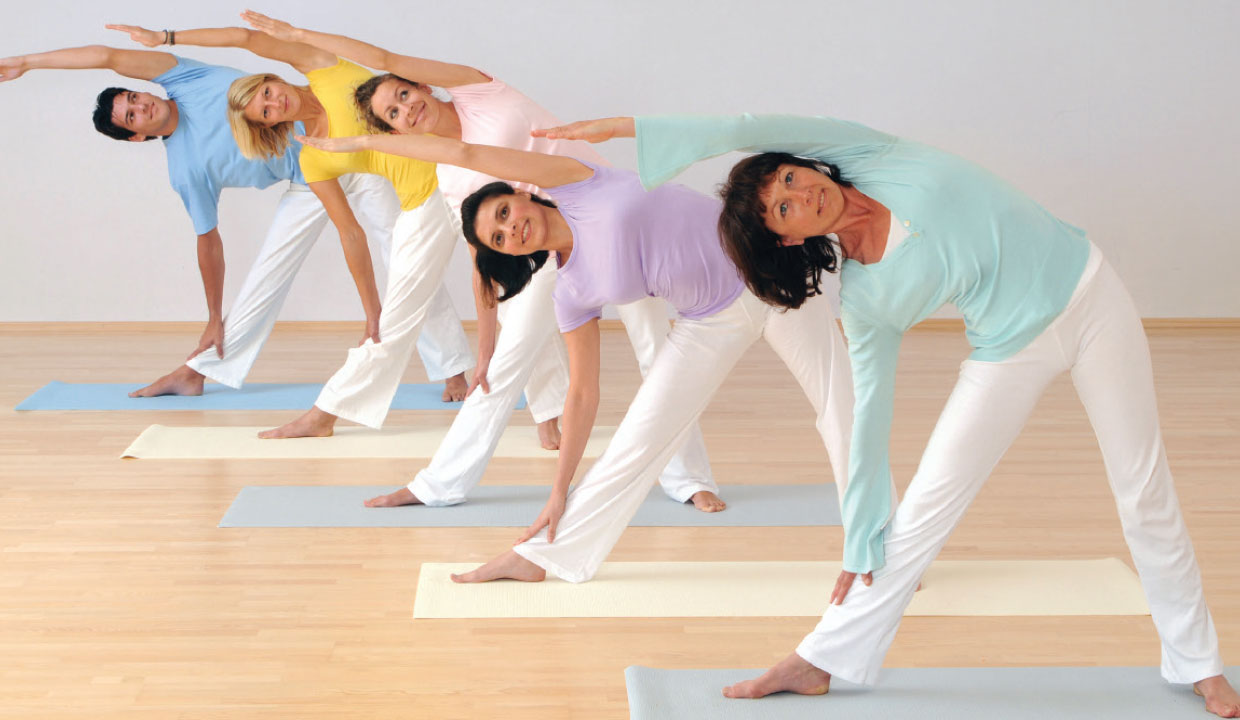
The logic of the sequence of the 12 Basic Asanas
The ancient Hatha yoga writings of India(*) give detailed descriptions of pranayama and meditation techniques, but offer only little instruction on practicing asanas. The classical asana sequences known to us today were passed down orally through the generations. They combine in a masterly way health-promoting effects with the awakening of subtle energies, and thus prepare for the practice of pranayama and meditation. (*) Hatha Yoga Pradipika, Gerandha Samhita, Siva Samhita
By Swami Sivadasananda
Reading time: 6 minutes
This is how the 12 basic poses work in conjunction with conscious breathing and deep relaxation:
![]()
Gentle stimulation of the circulatory system:
Fitness workout programmes today strongly emphasise a balanced cardiac workout. Yoga Asanas include this aspect very specifically:
- Inverted poses and abdominal breathing increase the venous return to the heart, thus stimulating a stronger heart beat.
- The massage action of specific pressure on internal organs increases the local blood circulation ensuring a rich supply of oxygen and nutrients to all cells of the body.
![]()
Hormonal balance:
The inverted poses increase the blood supply to the brain. This improves neuronal control of the pituitary gland (hypophysis), whose hormones regulate such important endocrine glands as the thyroid gland (involved in cell metabolism) and the adrenal glands (emotional balance). Specific asanas work like a massage, enhancing cellular functions in each gland.
![]()
Deep relaxation with auto-suggestion:
Impulses transmitted by motor and sensory nerves are regulated or registered in two adjacent areas of the cerebrum. The wave of relaxation which begins in the feet and ends in the head, 'visualisation' (motor), and 'feeling of relaxation' (sensory) impulses are barely distinguishable. That is no surprise, seeing the proximity of the respective area of the brain dedicated to sensory and motor activity. The short period of relaxation between the asanas is essential to harmonise motor and sensory impulses.
![]()
Nadis (meridians):
The classical yoga texts speak of 72,000 subtle nerve channels through which prana (vital energy) flows in and around (aura) the body. Pranic blockages at junctions of nadis can lead to a lack (and, conversely, an excess) of energy in different parts of the body. The 12 basic poses exert pressure on these points in a way that balances the prana, much like acupressure. That's one of the reasons why you feel rejuvenated after a yoga class.
![]()
Internal organs:
From the gastrointestinal tract to the liver and pancreas right through to the bladder - the pressure exerted by various asanas detoxifies these tissues and increases the supply of blood to them.
![]()
Yoga for the back:
Kyphosis (exaggerated upper back curve), lordosis (exaggerated lower back curve) and scoliosis (lateral deviation) are three common spinal problems. The asana sequence systematically improves these three postural habits and can often relieve the pain associated with them.
![]()
Balancing muscle length and muscle strength:
Yoga exercises develop both strength and flexibility, yet the body of a proficient practitioner will not show any extreme signs of body-building such as overdeveloped biceps muscles or permanent hyper-flexibility of the hip joints. This is because the practice of the twelve basic asanas develops flexibility and strength in equal measure.
![]()
Autonomic nervous system:
The stretching and relaxing in the first half of the asana sequence, as well as the contraction and relaxing in the second half, encourages the 'rest and repair' functions of the parasympathetic nervous system. At the same time, it prevents the overstimulation ('fight or flight' reaction) of the sympathetic nervous system.
![]()
Hatha Yoga, the union of Sun and Moon:
Prana (upwards moving energy, supporting respiration) is denoted by the Sun (Ha). Apana (downwards moving energy, supporting elimination) is called Moon (Tha). In the asana sequence these two vital energies merge in the solar plexus, creating a unique sensation of well-being.
![]()
Effects on the chakras:
The seven energy centres correspond to subtle elements and spiritual planes of consciousness. Advanced pranayama exercises, mantra repetition and meditation on the elements can awaken the cosmic Kundalini energy in the chakras. When the nerve plexuses in the physical body, which correspond to the chakras in the astral body, are stimulated through the asanas, the yoga practitioner may become aware for the first time that these energy centres really exist.
The Benefits of the Postures
Sirshasana - The Headstand
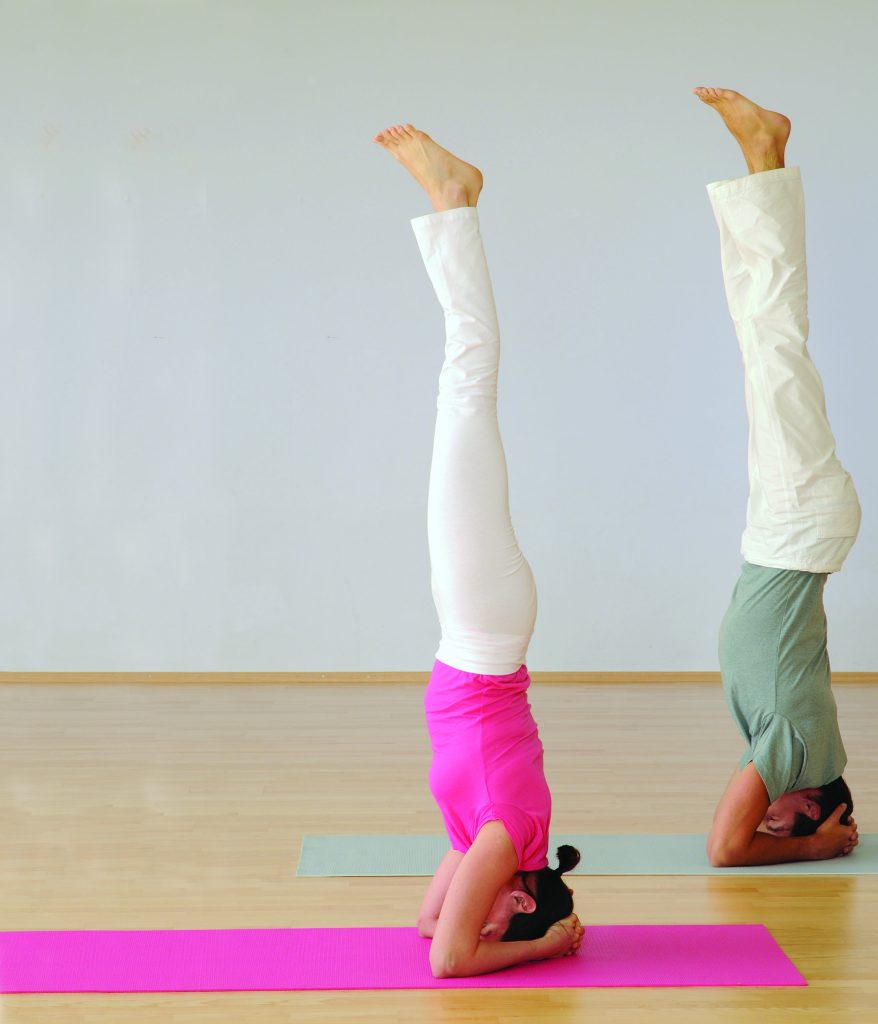
![]()
Counteracts gastroptosis (downward displacement of stomach). Contraindication: menstruation
![]()
Contraindication: neck injuries
![]()
Strengthens the muscles of the shoulder region
![]()
An increased supply of blood to the brain helps regulate the autonomic nervous system
![]()
Working the arm muscles and relaxing the legs improves one's sense of balance
![]()
Greater pranic flow to the head area
![]()
The inverted pose channels apana into the solar plexus.
![]()
Energises Ajna Chakra ('the third eye')
![]()
The increased venous flow of blood back to the heart strengthens the heart beat and relieves varicose veins; contraindication: chronic high blood pressure.
![]()
Improves the function of the pituitary gland (hypophysis)
Sarvangasana – The Shoulderstand
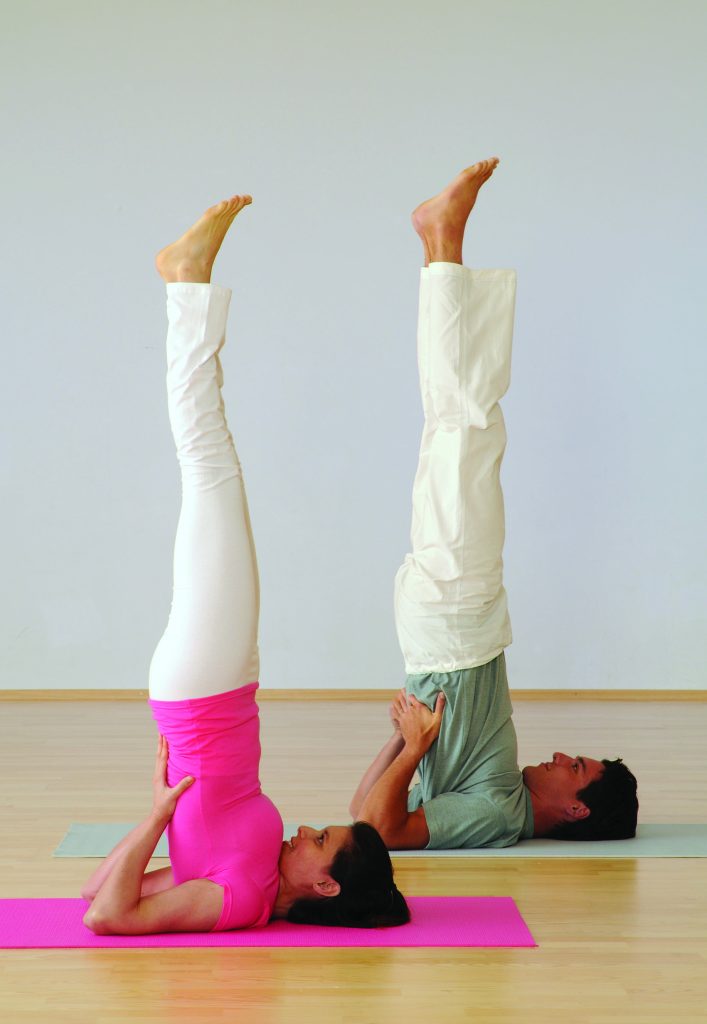
![]()
Both the inverted pose and the chin lock direct prana and apana into the solar plexus.
![]()
The increased venous flow of blood back to the heart strengthens the heart beat and relieves varicose veins. Contraindication: chronic high blood pressure
![]()
Stretches the neck and upper back and strengthens the lower back
![]()
Has a balancing effect on the thyroid andparathyroid glands
![]()
Contraindication: menstruation
![]()
Stretching relieves stress-related tension in the neck and shoulder region
![]()
Removes energy blockages in the neck area
![]()
Stimulates Vishuddha Chakra in the throat region.
Halasana – The Plough
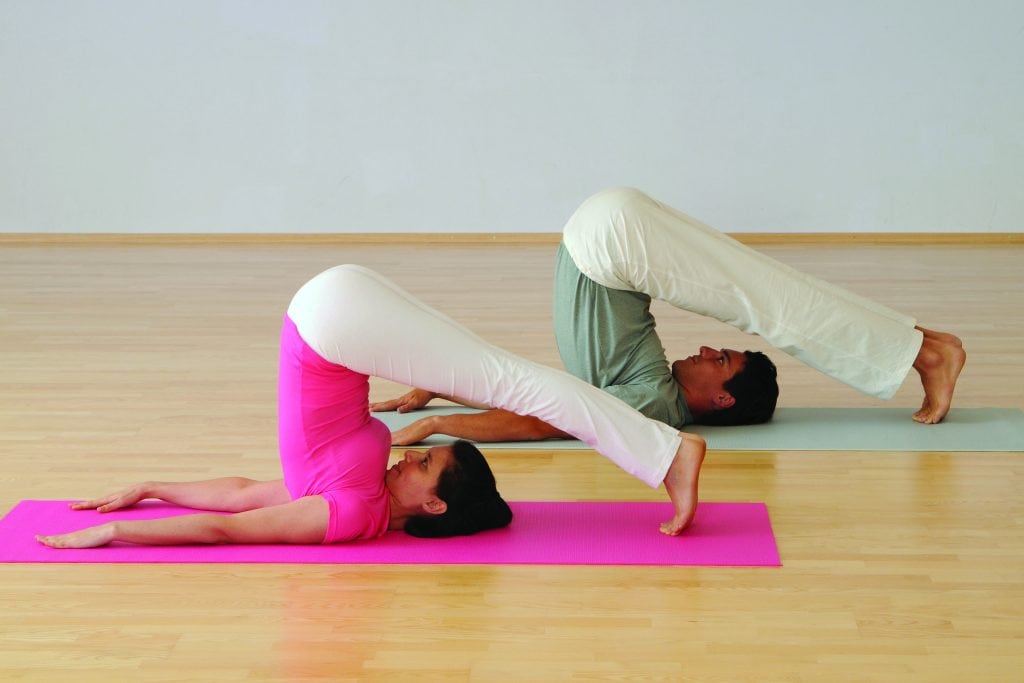
![]()
Removes energy blockages in the neck and back
![]()
Removes energy blockages in the neck and back
![]()
Combats lordosis (exaggerated lowerback curve)
![]()
Stretches the whole posterior side of the body from the toes to the neck
![]()
Gives a gentle massage to the abdominal organs
![]()
The long stretch stimulates the parasympathetic nervous system (relaxation)
Matsyasana – The Fish
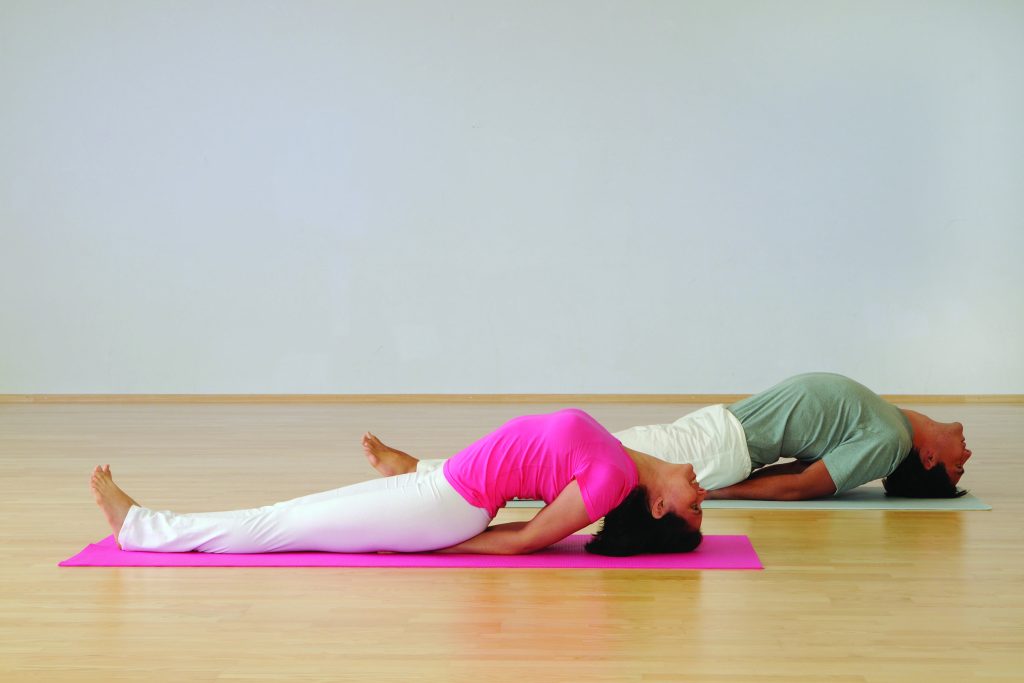
![]()
Relieves chronic bronchitis and asthma
![]()
The fish is a counter-pose to the shoulderstand and the plough. It has a balancing and relaxing effect on the entire back.
![]()
Stretching the abdomen enhances the union of prana and apana in the solar plexus
![]()
Combats kyphosis (exaggerated upper back curve)
![]()
Strengthens the arms and stretches the thoracic muscles
![]()
Has a balancing effect on the thyroid and parathyroid glands, and puts gentle pressure on the thymus gland (immune system)
![]()
Parasympathetic stimulation (relaxation) by stretching the throat, rib cage and abdomen
![]()
Removes energy blockages in the throat and neck region
![]()
Stimulates Anahata Chakra (heart chakra)
Paschimottanasana – The Forward Bend
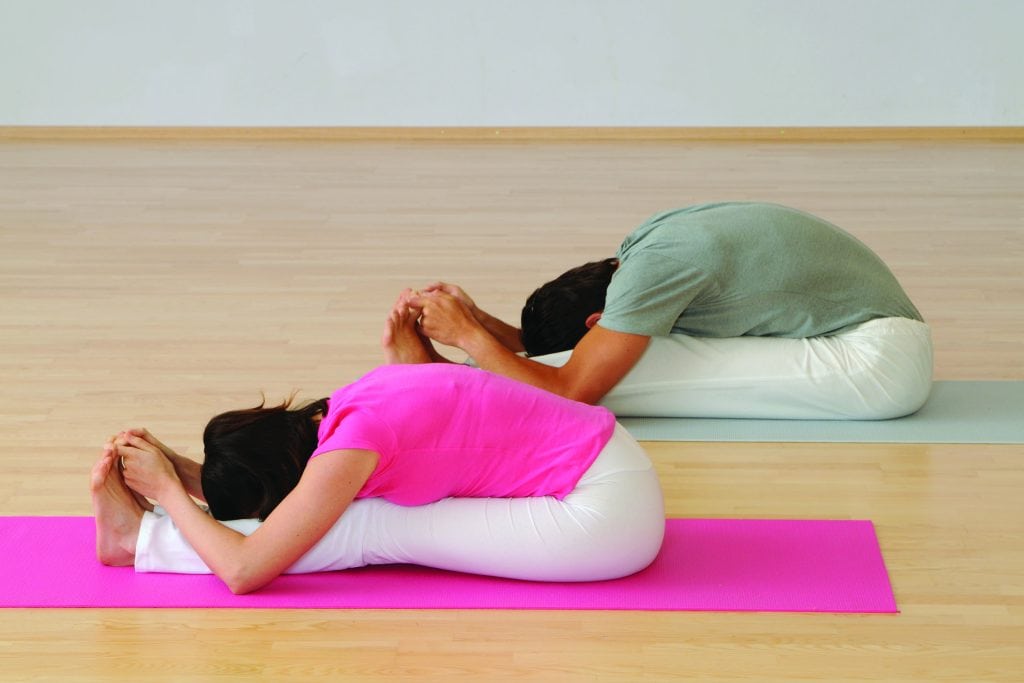
![]()
Parasympathetic stimulation (relaxation) through a complete stretch; has a strong calming effect
![]()
Releases energies in the main nadis along the spine
![]()
Stimulates the first three chakras (Muladhara, Swadhisthana, Manipura)
![]()
Combats lordosis (exaggerated lower back curve)
![]()
Stretches the whole posterior side of the body from the toes to the upper back
![]()
Gives a natural massage to the pancreas (helping to prevent diabetes)
![]()
Gently massages the abdominal organs
![]()
The body experiences a natural, deep relaxation following this asana
![]()
Intensifies the union of prana and apana in the solar plexus
Bhujangasana – The Cobra
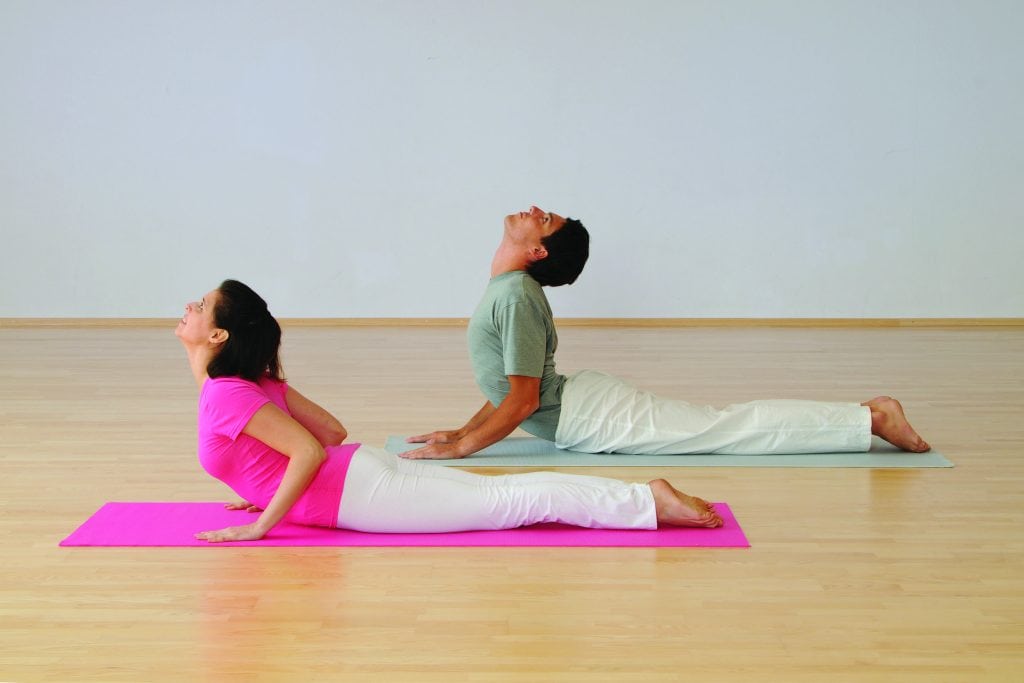
![]()
Relieves menstrual problems
![]()
Short and powerful contraction releases energy in the neck region
![]()
Dynamic exercise stimulates the circulatory system
![]()
Combats kyphosis (exaggerated upper back curve)
![]()
Strengthens the neck and upper back, stretches the thoracic muscles
![]()
Massages the female sex glands (ovaries)
![]()
Intensive tension/relaxation improves the body’s resistance to stress
![]()
Pressure on the solar plexus channels the united Ha – Tha (Sun Moon) energy back into the rest of the body
Salabhasana – The Locust
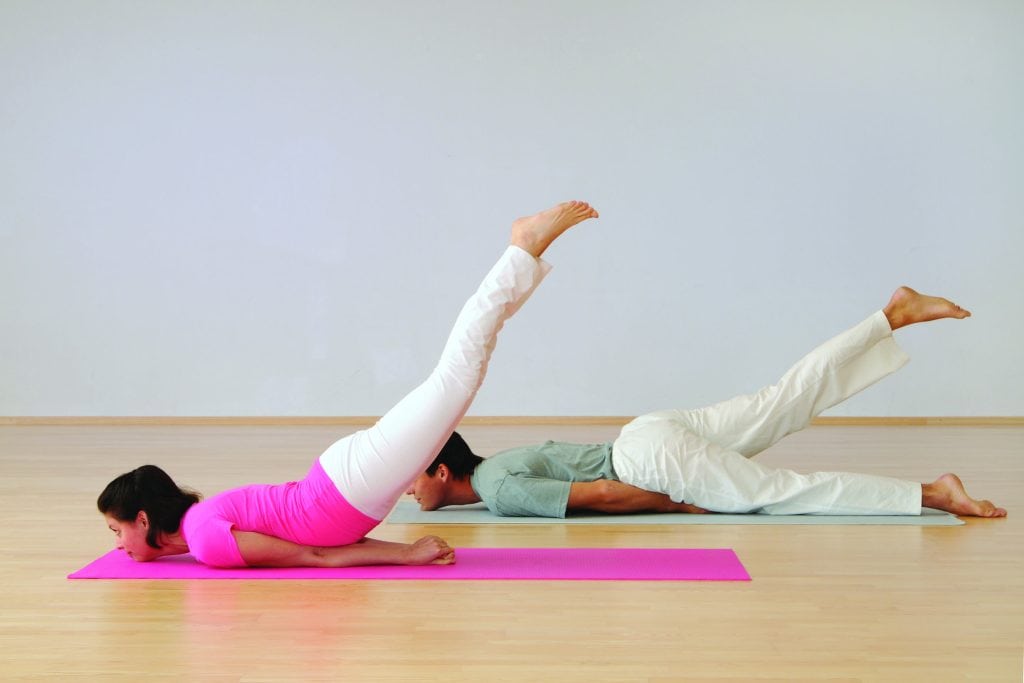
![]()
Pressure on the solar plexus channels the united Ha – Tha (Sun Moon) energy back into the rest of the body
![]()
Dynamic exercise stimulates the circulatory system
![]()
Strengthens the lower back, while protecting it in cases of lordosis (exaggerated lower back curve)
![]()
Strengthens the lower back
![]()
Massages the gastrointestinal tract
![]()
Intensive tension/relaxation improves the body’s resistance to stress
Dhanurasana – The Bow
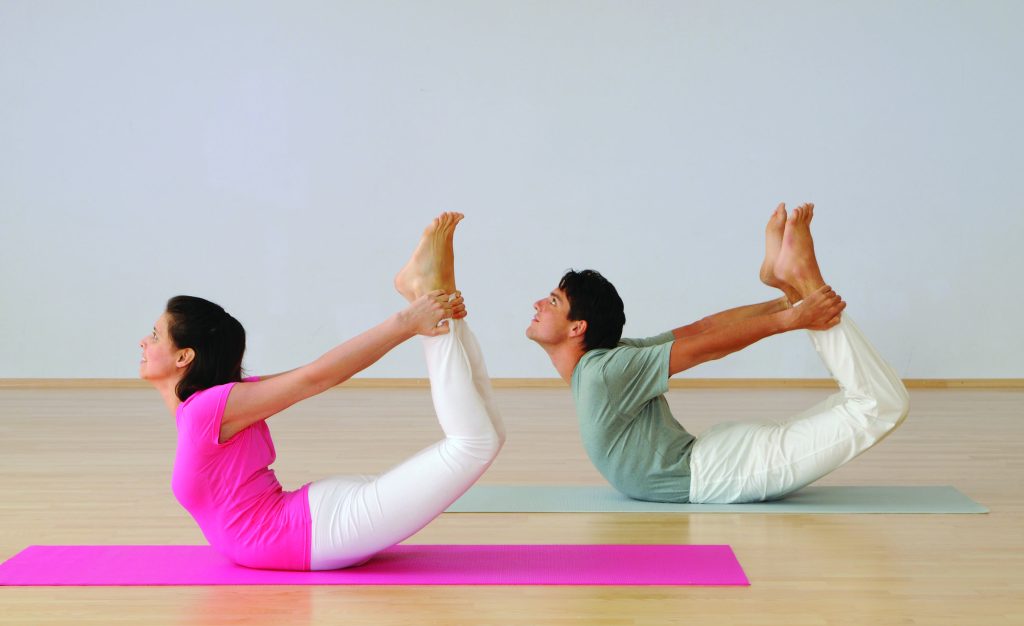
![]()
Gives an intense massage to all abdominal organs
![]()
Conscious contraction/relaxation improves the body’s resistance to stress
![]()
Dynamic exercise stimulates the circulatory system
![]()
Combats kyphosis (exaggerated upper back curve)
![]()
Stretches the thoracic muscles and strengthens the thighs
![]()
Massages the pancreas (preventing diabetes) and the female reproductive organs (ovaries)
![]()
Pressure on the solar plexus channels the united Ha –Tha (Sun – Moon) energy back into the rest of the body
Ardha-Matsyendrasana – The Half Spinal Twist
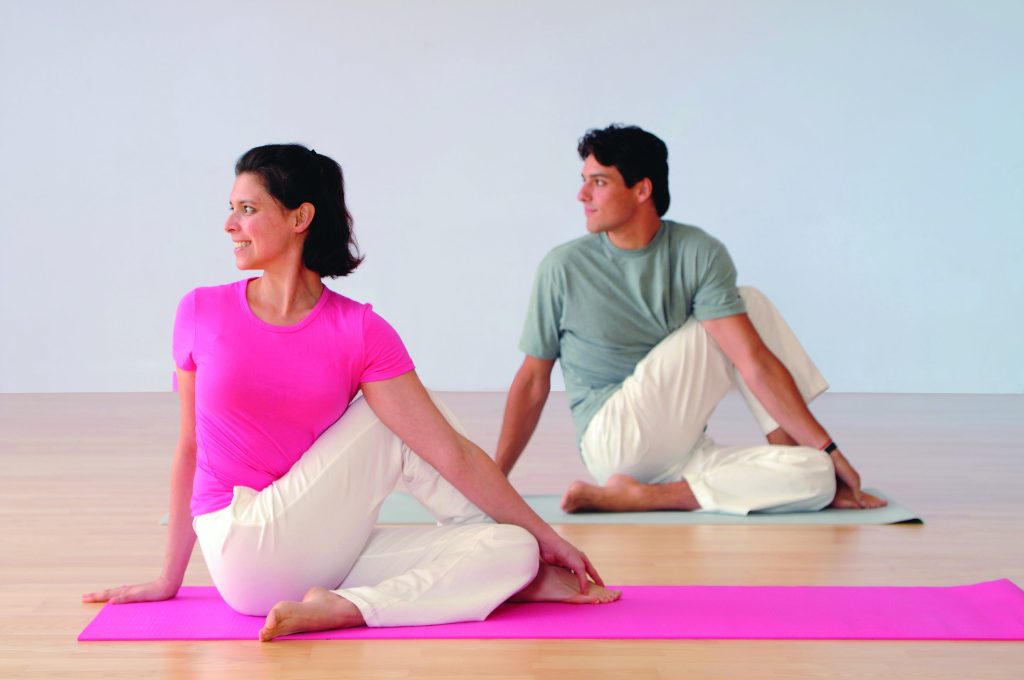
![]()
Harmonises the left and right hemispheres of the nadis
![]()
Combats scoliosis (lateral curvature)
![]()
Stretches the hip abductors and strengthens the back muscles
![]()
Massages the colon and relieves constipation
![]()
Reduces pressure on the roots of the spinal nerves, which in turn enhances the function of the peripheral nervous system
Mayurasana – The Peacock
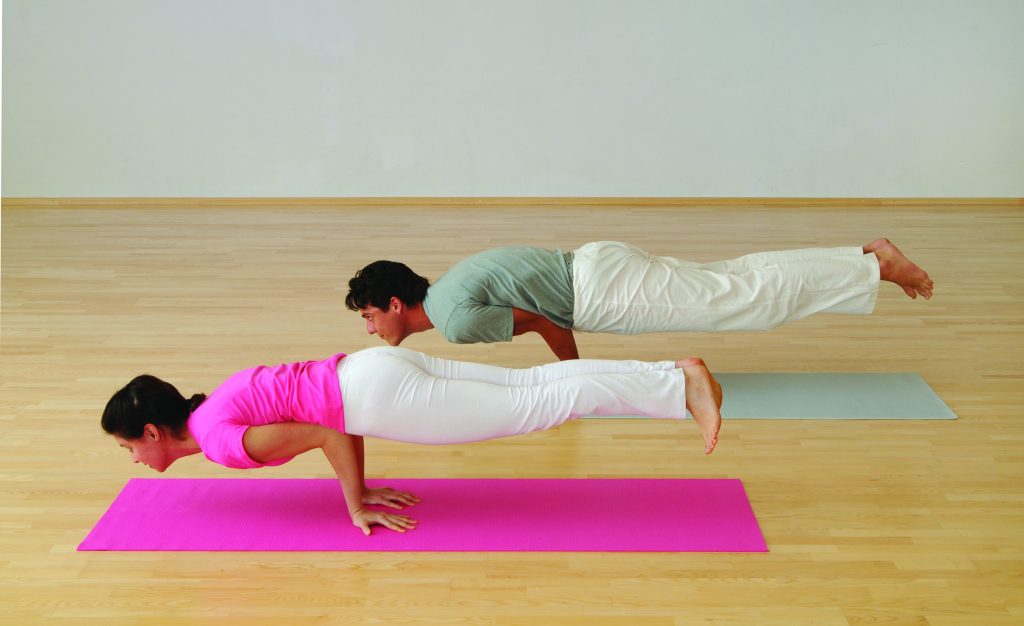
![]()
Massages the pancreas (preventing diabetes) and the female reproductive organs (ovaries)
![]()
Strong contraction/relaxation improves the body’s resistance to stress
![]()
Dynamic exercise stimulates the circulatory system
![]()
Combats kyphosis (exaggerated upper back curve)
![]()
Strengthens many muscles throughout the body
![]()
Optimal massage of all abdominal organs
![]()
Pressure on the solar plexus channels the united Ha–Tha (Sun–Moon) energy back into the rest of the body
Padahastasana – The Standing Forward Bend
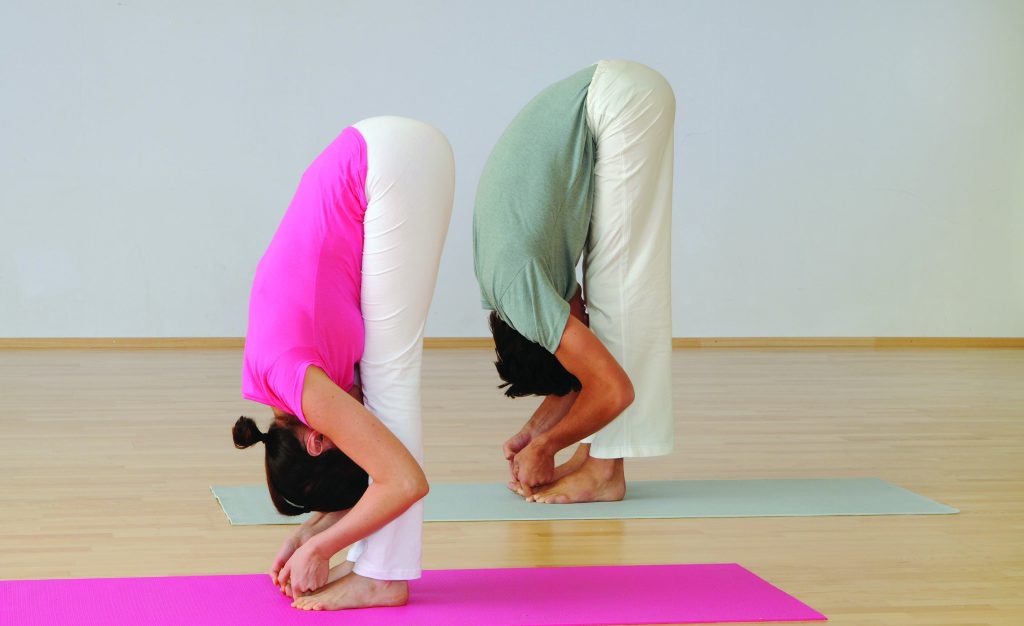
![]()
Gives a gentle massage to the abdominal organs
![]()
Releases energies in the main nadis along the spine
![]()
Gentle increase of blood circulation in the head; may also be practiced by people with chronic high blood pressure
![]()
Combats lordosis (exaggerated lower back curve)
![]()
Stretches the whole posterior side of the body from the toes up to the neck
![]()
Parasympathetic stimulation (relaxation) through a complete stretch
Trikonasana – The Triangle
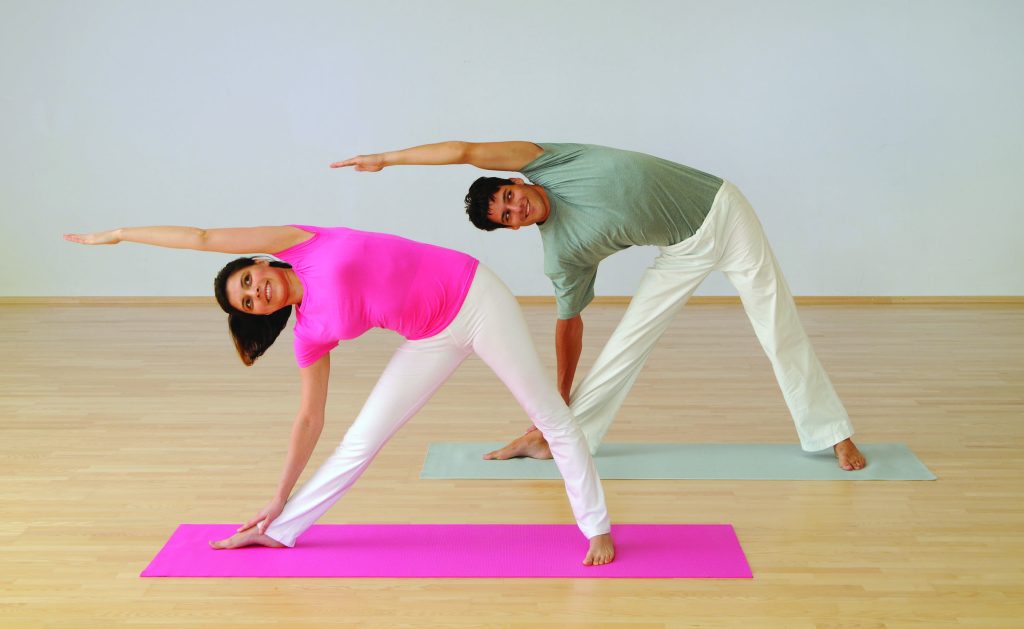
![]()
Massages the kidneys
![]()
Equal measure of stretching and tensing develops stress resistance
![]()
Harmonises the left and right hemispheres of the nadis
![]()
Dynamic exercise stimulates the circulatory system
![]()
Combats scoliosis (lateral curvature)
![]()
Simultaneously stretches and strengthens the inner hip muscles (Iliopsoas)
![]()
Increases the supply of blood to the adrenal glands
![]()
Building strength in the lateral muscles of the back has a very relaxing effect on the entire back
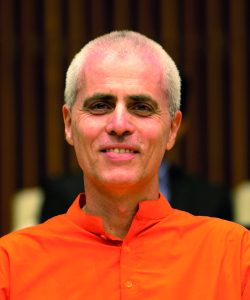
Swami Sivadasananda is one of the acharyas and senior teachers of the Sivananda Yoga Vedanta Centres in Europe. He is author of The Sivananda Beginners Guide to Yoga and Yoga – Your Home Practice Companion. He teaches in the Sivananda Yoga Teachers’ Training Courses world-wide and gives the Live Online and free of charge: 'FIRE OF YOGA' workshop, every Saturday and Sunday at
3 PM GMT with other senior Sivananda teachers. Contact: reith-office@sivananda.net


